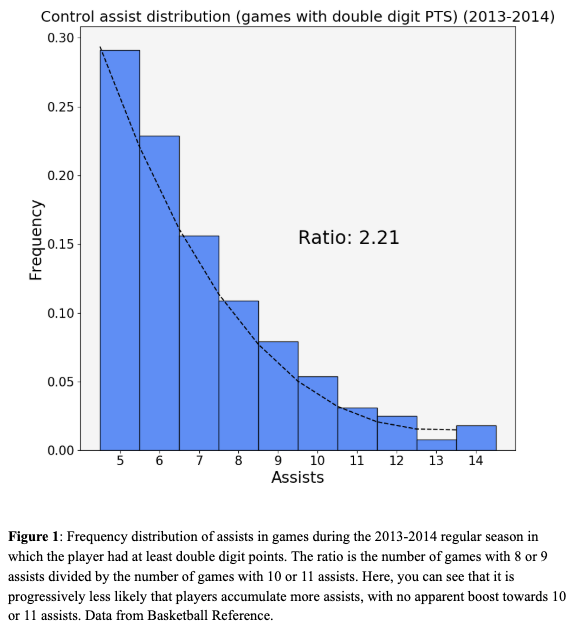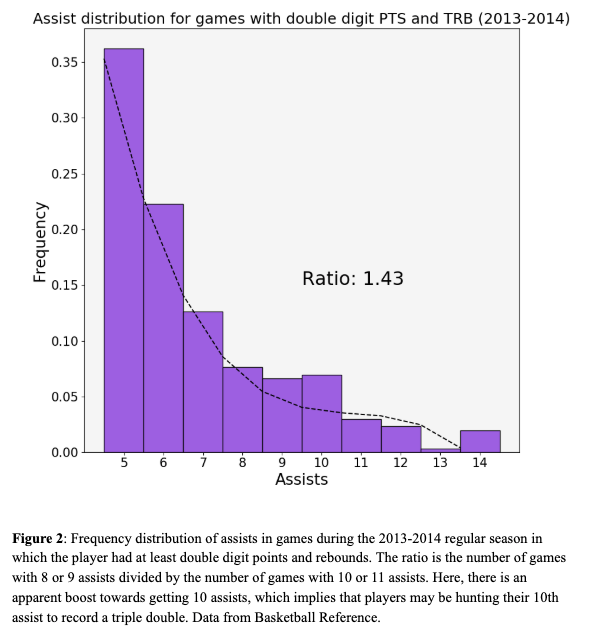Author: Jeremy Brooks (Weinberg ’20)
During the 2013-2014 NBA regular season, 46 triple doubles were recorded, and the league leader was Lance Stephenson with 5. In stark contrast, 127 triple doubles were recorded during the 2018-2019 season, and eight different players tallied at least 5 triple doubles. While triple doubles themselves are an arbitrary statistical convention, they are a constant focus of fan, media, and player attention and a benchmark for all-around excellence. Over the last five seasons, the rise in triple doubles has been a natural consequence of the severe stylistic changes the NBA has undergone. In this article, I examine the statistical shifts that influence the frequency of triple doubles in the NBA. These statistical shifts trace the many different ways the NBA has recently evolved.
So, what changes influence the frequency of triple doubles? In this article, I examine the following five potential reasons:
- Increase in pace.
- The increase in “triple double capable” players.
- Small ball lineups and the effect on rebound distribution.
- More assisted shots.
- Increased “stat padding”.
Increased pace
Perhaps the most important stylistic change has been the sharp uptick in pace over the last five seasons, rising from 93.9 possessions per 48 minutes in 2013-14 to 100.0 in 2018-19. With greater pace comes more chances for players to get points, rebounds, and assists. However, the impact of increased pace is lessened by the decline in minutes that the NBA’s best players play on average. Among the top 100 players in minutes per game, the median playing time dropped from 33.3 minutes per game in 2013-14 to only 31.9 in 2018-19. The combined effect of increased pace but declined minutes have led to an increase in possessions per game among most NBA players; rising from a median of 65.1 to 66.5 possessions per game for the league’s top 100 players in minutes per game.
The increase in “triple double capable” players
Here, I define a player as “triple double capable” if they are simultaneously prolific passers and rebounders while also being solid scorers. Players that fit this rare archetype (best encapsulated by players such as Oscar Robertson, Magic Johnson, and LeBron James) are able to achieve triple doubles with some regularity. Therefore, the addition of even one triple double capable player in the NBA may dramatically increase league-wide triple double numbers because the bulk of the NBA’s triple doubles are accumulated by just a few players. For example, in 2018-2019, the top 8 leaders in triple doubles were responsible for 90 of the 127 triple doubles (71%).
A massive contributing reason for the increase in triple double frequency is that there are more players that fit the triple double capable archetype now than five seasons ago. Since 2013-14, Ben Simmons, Elfrid Payton, Luka Doncic, and Nikola Jokic (who have combined for 85 career triple doubles) have entered the league. Additionally, Giannis Antetokounmpo (14 career triple doubles) has developed from a deep bench player to an MVP-caliber player. Finally, Russell Westbrook (101 triple doubles over the last three seasons) has had his role dramatically increase since the departure of Kevin Durant, making it easier for him to accumulate mind-bending box score numbers.
This trend is also evident by looking at per game averages as a proxy for triple double capability. In 2013-14, only 8 players had per game averages of 8+ points, 5+ rebounds, and 5+ assists. In 2018-19, 18 players reached those numbers, meaning that the league has seen an increase in versatile players that fit the triple double capable archetype.
Small ball lineups and the effect on rebound distribution
Many of the league’s dominant triple double threats play the guard or forward positions, which do not traditionally dominate rebounding. However, the NBA has stylistically shifted towards using small ball lineups without traditional centers with much greater frequency than just a few seasons ago. The result is that traditional bigs are either pulled out to the perimeter or played off the floor entirely. Consequently, teams have less rebounding from their center position and compensate by redistributing rebounding opportunities among the remaining players on the court. Statistically, this trend is clear: in 2013-14, centers accounted for 36.2% of their team’s rebounds, but in 2019-19 that number dropped down to just 31.9%. In place of traditional rebounding-focused centers, more rebounds are available for the player archetypes (usually guards and forwards) that are capable of achieving triple doubles.
The rise in three-point shooting and assisted shots
The rise in three-point shooting (from the average team shooting 21.5 per game to 32.0) over the last five seasons has affected the amount of assisted shots in the NBA. Three-point field goals are assisted 82% of the time, which is a much higher assist percentage than mid-range shots, which are typically generated by dribble moves rather than passing. Therefore, the substitution of mid-range attempts with more three-point attempts has resulted in a total rise in assisted field goals from 58% to 60% over the last five seasons. Therefore, assist totals have become more inflated, making it easier to record triple doubles.
Increased stat padding: Finding statistical evidence
Over the last few seasons, fans and analysts have frequently dismissed the rise of triple doubles as a result of “stat padding”, with attention focused especially on Russell Westbrook’s gaudy triple double records. While the above reasons demonstrate that there are many legitimate, traceable stylistic changes in the NBA that have caused the rise in triple doubles, I will also investigate if stat padding is prevalent in the NBA, and if it has increased since 2013-2014.
Measuring stat padding solely from box score statistics is an imperfect exercise, but one simple test is to compare the number of “near misses” (games with 10+ of two statistical categories, but only 8 or 9 of another category) versus the number of triple doubles, and then comparing that ratio with a control. Here, I carry out this test using assists. The control is the assist distribution of all player-games in the 2013-2014 season in which a player recorded over 10 points (Figure 1). The experimental data is the assist distribution of the set of player-games in the 2013-2014 season in which a player recorded double-digit points and rebounds (Figure 2). For both the control and experimental data, I calculated the ratio of the frequency of 8 or 9 assist games (“near misses” if the player already had a double-double) compared to the frequency of 10 or 11 assist games (this is the ratio included in each figure). The smaller ratio for the experimental data (1.43) compared to the control data (2.21) indicates that it is far more likely that players with double-digit points and rebounds also record double-digit assists than it is for players with just double-digit points. Therefore, there is a statistically-evident propensity to avoid “near misses”, thus this simplified test suggests that stat padding is prevalent in the NBA.
The next step is to conduct the same test for the 2018-2019 season and analyze if the statistical trend is different. The control data (Figure 3) and experimental data (Figure 4) are similar to 2013-2014, but for each, the ratios are smaller (1.61 for control; 1.28 for experimental). The smaller experimental ratio in 2018-2019 compared to 2013-2014 shows an even stronger propensity to avoid “near misses”, which thereby suggests that stat padding has increased since 2018-2019. More rigorous tests must be conducted to verify this conclusion (including similar tests for rebound distributions and analyzing the game film to see if player behavior changes when close to a triple double). However, the statistical analysis done here indicates that stat padding to achieve triple doubles does occur in the NBA and that it is more prevalent now than five seasons ago.
Article Disclaimer: all statistics cited in this article were gathered from Basketball-Reference. Upon request, the author is happy to send the Excel spreadsheets used to calculate some of the numbers used in this article.





Be the first to comment on "The Rise of Triple Doubles in the NBA: Examining the Statistical Causes"